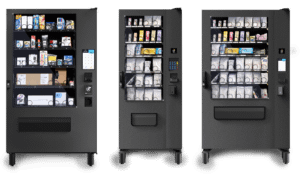Over the last few years, you’ve no doubt gotten used to the fact that vending machines are no longer just a source for soft drinks and salty snacks. You’ve probably purchased at least one electronic device from a vending machine in an airport, or have at least seen someone do so. You’ve maybe even used a DVD vending machine or gotten your morning paper in much the same way. Now, providers are taking things to the next level by offering prescription dispenser units and other medical vending machine options.
Arizona State University’s Prescription Medication Vending Machine
In 2014, Arizona State University became one of the first educational institutions in the country to install a prescription dispenser on campus. Located in the Health Services Building, this unit was designed to help both make sure that people had quick and easy access to the medical supplies that they needed and to increase efficiency within that organization at the exact same time.
The medical vending machine was designed to fill the medical prescriptions of both students and university employees at a moment’s notice. By using a voucher with identifying information that itself is tied to a very specific code, any doctor could prescribe medication to a patient that could then be picked up at the vending machine within 24 hours.
This advancement couldn’t have come at a better time, too, as the pharmacy at Arizona State University closed just a few weeks prior. Thanks to the prescription dispenser, people were able to continue getting the service they needed without transferring to other pharmacies or seeing any other type of negative impact at all.
At its launch, the prescription medication vending machine offered the 50 medications that were most commonly prescribed to students on campus. Based on the type of software that the machine was powered with, this could change on a regular basis as trends did. If a new medication were to creep into that top 50, it would be added to the list and something that was less likely to be prescribed would be removed.
UCapIt
UCapIt is just one example of a company that is offering controlled access pharmaceutical dispensing options to healthcare organizations around the world on a daily basis. UCapIt solutions are armed with state-of-the-art software that allows not only for instant recording whenever a purchase is made, but also for things like detailed reporting, the tracking of who has access to which types of supplies, advanced inventory management capabilities and more.
This is just one example of the many ways that medical vending machine technology is positively impacting the lives of people all over the world on a daily basis. For students at Arizona State University, they found the process of filling a prescription was easier than ever before. It’s easy to picture a time not too far from now where these types of medical vending solutions are rolled out beyond college campuses and are located in drug stores, pharmacies and other locations across the world.


